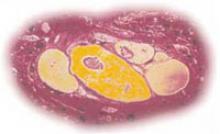- In most cases, loop electrosurgical excision procedure (LEEP) and cold-knife conization (CKC) result in equivalent success rates and margin status.
- CKC is preferred in cases of adenocarcinoma in situ or squamous microinvasion.
- Conservative follow-up is generally possible in adenocarcinoma in situ and squamous microinvasion when margins are negative.
- Colposcopy, endocervical curettage, and biopsies should be part of the follow-up strategy for patients with positive margins.
When cervical intraepithelial neoplasia (CIN) requires treatment, loop electrosurgical excision procedure (LEEP) is the most frequently used modality, although cold-knife conization (CKC) of the cervical transformation zone still is preferred in select cases. Since excisional techniques are used with CKC, margin status is known and clinical decisions may be based on this information.
This article reviews current indications for excisional biopsy and presents evidence to direct management and follow-up of patients with positive and negative margins.
Selecting a technique
Several large randomized and prospective studies have demonstrated that LEEP is similar in efficacy to CKC and may even remove less of the normal cervical stroma.1-3 In general, LEEP is used to excise high-grade and recurrent squamous dysplasia, as it is similar to CKC in its rates of incomplete excision and residual disease.1,4 However, when adenocarcinoma in situ (AIS) is present, CKC is preferred for diagnosis and treatment, since it results in a lower incidence of involved margins and a lower recurrence rate.3,5-7
CKC also is preferred when histologic confirmation of the margin status is crucial, such as when invasion with squamous lesions is suspected. This is because thermal artifacts that may result from LEEP will interfere with interpretation, further complicating treatment planning.1,4,8,9 In cases of microinvasion, the ability to confirm margins makes conservative treatment possible; if the depth of invasion cannot be determined from the specimen, radical surgery may be necessary.
In the hands of an experienced clinician, however, thermal artifact from the LEEP technique generally is not a significant problem. Series reporting high rates of uninterpretable margins have been attributed to operator inexperience.10 In general, thermal artifact is reduced by limiting the number of sections taken. In ideal cases, only a single-piece specimen is obtained, similar to that achieved using CKC.8,10,11 Newer loops, such as the cone biopsy excision loop, may decrease the number of sections and further improve margin interpretation.8
I use CKC in cases of suspected squamous invasion and in the evaluation of glandular lesions, but feel that in other cases LEEP is efficacious and quicker.
Identifying residual disease
When both the endocervical margin and endocervical curettage (ECC) are positive for squamous dysplasia at the time of excision, there is an increased risk of residual disease (TABLE 1).12-14 However, it is not clear whether ECC alone is an independent predictor of residual disease. Although 1 study suggests an increased risk of invasive cancer in women over 50 years of age with a positive ECC at the time of conization, other series have failed to demonstrate a difference in treatment failure rates based on ECC.15-17 Thus, the utility of ECC in directing further therapy at the time of excisional biopsy is unclear. I generally do not perform an ECC with LEEP for squamous dysplasia.
In AIS, a positive ECC is a strong predictor of residual disease, while a negative ECC is of limited significance.18 I am more likely to perform an ECC with glandular lesions. If it is negative, close follow-up still is indicated. If it is positive, repeat excision may be necessary.
TABLE 1
Residual disease and margin status: squamous dysplasia
| AUTHOR | PROPORTION WITH RESIDUAL DISEASE | |||
|---|---|---|---|---|
| NEGATIVE MARGINS | POSITIVE MARGINS | |||
| NUMBER | % | NUMBER | % | |
| SQUAMOUS LESIONS | ||||
| Bertelsen et al, 199923 | 44/485 | 9 | 29/76 | 38.2 |
| Moore et al, 199524 | 170/523 | 32.5 | 37/91 | 40.7 |
| Lopes et al, 199325 | 0/176 | 0 | 11/131 | 8.4 |
| Murdoch et al, 199226 | 7/405 | 1.7 | 22/160 | 13.8 |
| Andersen et al, 199019 | 0/411 | 0 | 6/469 | 1.3 |
| TOTALS | 221/2,000 | 11 | 105/927 | 11.3 |
| SQUAMOUS MICROINVASION | ||||
| Gurgel et al, 199727 | 6/74 | 8.1 | 45/76 | 59.2 |
| Roman et al, 199722 | 1/30 | 3.3 | 7/50 | 14 |
| TOTALS | 7/104 | 6.7 | 52/126 | 41.3 |
Follow-up of squamous lesions
Considerable clinical uncertainty remains over the relative strengths of cytologic, colposcopic, and histologic evaluation for residual or recurrent disease following excisional biopsy. Conservative management includes Papanicolaou smears alone or in combination with ECC and/or colposcopy.
Negative margins. If margins are negative, the success rate of excisional biopsy is high (90%-100%), and careful observation is the preferred follow-up. Repeat cytologic testing will identify the majority of patients with residual high-grade disease. A prospective randomized trial of cytologic surveillance showed that the detection rate was only 1.9% higher for histology.19 Although 1 report suggests that colposcopy can expedite the diagnosis of recurrent dysplasia, it is unclear from this report whether colposcopy identified significant high-grade dysplasia that cytology missed.20
Positive margins. In most series involving CIN with positive margins, treatment success rates do not differ significantly between patients who undergo repeat surgical procedures and those who have close follow-up. However, endocervical margin involvement appears to carry a higher treatment failure rate than ectocervical margin involvement. Data are conflicting on the proper method of conservative follow-up. Some authors propose only frequent cytologic testing, while others recommend that colposcopy be performed.19-21


